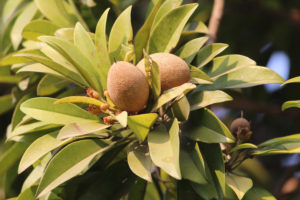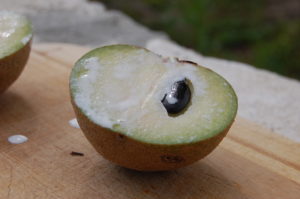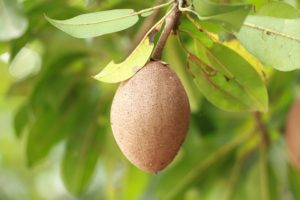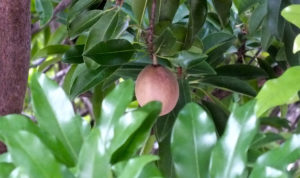Sapodilla, also known as chico fruit, is a long lived, evergreen tree native to southern Mexico, Central America and the Caribbean. An example of a natural occurrence is in coastal Yucatan in the Petenes mangroves ecoregion, where it is a subdominant plant species. Take a look below for 23 more interesting and fascinating facts about sapodilla.
1. Sapodilla was introduced to the Philippines during Spanish colonization.
2. It’s grown in large quantities in Pakistan, India, Thailand, Malaysia, Cambodia, Indonesia, Vietnam, Bangladesh and Mexico.
3. Sapodilla can grow to more than 30 meters, or 98 feet, tall with an average trunk diameter of 1.5 meters, or 4.9 feet. However, the average height of cultivated specimens is usually between 9 and 15 meters, or 30 and 49 feet, with a trunk diameter not exceeding 50 centimeters, or 20 inches.
4. The fruit is a large berry, 4 to 8 centimeters, or 1.6 to 3.1 inches, in diameter. Inside, its flesh ranges from a pale yellow to an earthy brown color with a grainy texture akin to that of a well-ripened pear.

5. The fruit has an exceptionally sweet, malty flavor. The unripe fruit is hard to the touch and contains high amounts of saponin, which has astringent properties similar to tannin, drying out the mouth.
6. The trees can only survive in warm, typically tropical environments, dying easily if the temperature drops below freezing.
7. From germination, the sapodilla tree will usually take anywhere from five to eight years to bear fruit.
8. The trees yield fruit twice a year, though flowering may continue year round.
9. Compounds extracted from the leaves of sapodilla trees showed anti-diabetic, antioxidant and hypocholesterolemic effects in rats.
10. Traditionally, sapodilla was used to treat diarrhea. The infusion of the young fruits and flowers helps to soothe the pulmonary ailments.

11. Sapodilla is high in fiber content. This makes the fruit very good for digestion and for treating constipation.
12. Sapodilla has tannin substances. Tannins have several beneficial applications medicinally, but they are most commonly used to treat hemorrhoids and diarrhea.
13. The fruit contains important vitamins like Vitamin A and Vitamin C. Vitamin A helps to ensure proper vision and helps to maintain healthy skin and mucus membranes. Vitamin C helps the body develop a resistance against pathogens and to get rid of free radicals.
14. Consumption of sapodilla with a pinch of salt is a recommended home therapy for curing constipation.
15. Sapodilla is extremely valuable in stopping the loss of blood. It helps in creasing blood loss in piles, injuries and in many other medical terminologies.
16. The fruit helps in lessening viral diseases in addition to bacterial infections within the body. It also decreases inflammation caused by swelling and helps to ease pain.

17. The latex of the sapodilla plant is the source of chicle, the chewing gum of the Aztecs.
18. Sapodilla is consumed raw by scooping the flesh out or made into jam or sherbet. It’s also added to pancakes and cakes. The fruit can also be found in the form of custard, juice, ice cream and milkshakes.
19. The intake of unripe sapodilla causes irritation in the throat, breathing problems and mouth ulcers.
20. Raw sapodilla has a bitter taste due to the high amount of latex and tannins.
21. Sapodilla is known as “mispel” in the Virgin Islands and Dutch Caribbean, “zapote” in Honduras, “nispero” in the Dominican Republic, El Salvador, Costa Rica, Cuba, Guyana, Puerto Rico, Nicaragua, Panama, Colombia and Venezuela, “dilly” in the Bahamas, “naseberry” in Jamaica and other parts of the Caribbean, “sapoti” in Brazil and Haiti, “chico” in the Philippines and “chicosapote” or “chicozapote” in Mexico, Hawaii and Florida.

22. In Chinese, the name is mistakenly translated by many people roughly as “ginseng fruit”, though that is also the name used for the pepino, an unrelated fruit.
23. It’s called “ciku” in standard Malay and “sawo nilo” in Kelantanese Malay.




